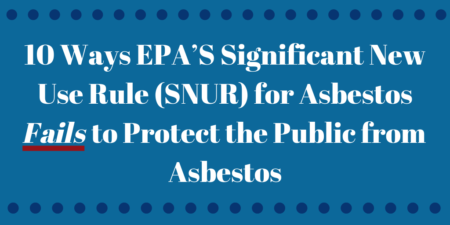Posted on April 17, 2019
TEN WAYS EPA’S SIGNIFICANT NEW USE RULE FOR ASBESTOS FAILS TO PROTECT THE PUBLIC FROM ASBESTOS
 On April 17, 2019, the EPA issued a significant new use rule (SNUR) for asbestos under the Toxic Substances Control Act (TSCA). This rule is not a ban. In fact, it falls woefully short of taking meaningful action to protect public health. The Asbestos Disease Awareness Organization, the largest asbestos-victim advocacy organization released this list of the 10 ways the SNUR fails to protect public health.
On April 17, 2019, the EPA issued a significant new use rule (SNUR) for asbestos under the Toxic Substances Control Act (TSCA). This rule is not a ban. In fact, it falls woefully short of taking meaningful action to protect public health. The Asbestos Disease Awareness Organization, the largest asbestos-victim advocacy organization released this list of the 10 ways the SNUR fails to protect public health.
- The SNUR is NOT a ban on asbestos. It merely requires companies to notify EPA if they plan to reintroduce one of the obsolete asbestos products listed by EPA in the final rule. A ban on all asbestos imports and uses would go far beyond this rule and provide assurance that asbestos exposure will be permanently eliminated.
- EPA has not evaluated the risks of these products and has made no finding that they are unsafe.
- EPA can decide to take no action after a company has provided notice of its plans to reintroduce one of the listed products. If EPA takes no action, the manufacture and sale of the discontinued product could resume without restriction.
- There is no guarantee EPA will in fact restrict any of these products if they return to the marketplace. EPA has reviewed many other chemicals under the provisions of TSCA on which the SNUR is based and concluded that they are “unlikely to present an unreasonable risk of injury” even though EPA scientists have identified the potential for serious risks to human health. This may happen for asbestos.
- EPA easily could have included these obsolete products in its ongoing TSCA asbestos risk evaluation, leading to a conclusion that they present an unreasonable risk of injury, which could have then enabled the agency to permanently and unconditionally ban them from the US.
- The SNUR would not affect Libby Amphibole, winchite- richterite, a form of asbestos that is extremely hazardous and has caused numerous deaths in Montana and throughout the nation.
- Imports of raw asbestos and currently imported asbestos-containing products would be outside the scope of the SNUR and could continue without restriction. This includes aftermarket automotive brakes/linings and other vehicle friction products, oilfield brake blocks, other gaskets and packing, plus the substantial imports of raw asbestos that are used in the manufacture of chlorine and caustic soda.
- The SNUR does not affect — and EPA is not addressing — crayons, toys, and other consumer products contaminated with asbestos that put children and families at risk.
- Neither the SNUR nor the ongoing risk evaluation addresses the millions of tons of legacy asbestos present in buildings across the US, where they pose significant risks to residents and workers, including fire-fighters.
- The SNUR applies to products like asbestos cement and woven fabric, which EPA and USGS have previously identified as materials currently being imported into the US. This creates a regulatory loophole that removes these products from the scope of the EPA’s ongoing asbestos risk evaluation and exempts them from a possible ban.
